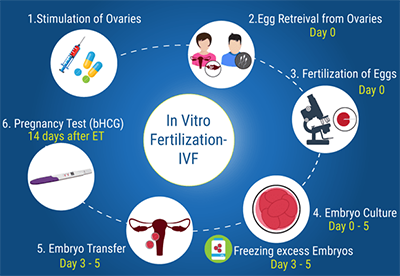The Process Of IVF
The Process Of IVF

In Vitro fertilization or IVF, requires a number of steps from ovarian stimulation to embryo transfer before pregnancy can take place. You will need to understand the various steps involved so that you will be better prepared as you go through a cycle.
STEP 1
OVARIAN STIMULATION AND MONITORING
In a normal cycle, a single egg is released from the ovary every month. To maximize the chances of successful fertilization with each IVF attempt, your ovaries will be stimulated to produce multiple mature follicles. Some drugs will be used for this purpose i.e. menopour, puregon, pergonal, humegon, metrodin, etc. The growth and development of eggs is closely monitored by repeated ultrasound and or blood tests. Based on information obtained from these tests, we can determine when ovulation will take place. Release of eggs from the ovary is then achieved by administering an injection called HCG or Buserelin depending on the response. You will then be ready for egg collection. Occasionally hyper stimulation occurs, giving rise to OHSS (Ovarian Hyperstimulation Syndrome)
STEP 2
EGG COLLECTION
This takes 34-36hours after hcg injection. Egg collection is performed at the clinic via a transvaginal route under conscious sedation and local anesthesia. Direct vision through ultrasound imaging helps to identify and retrieve eggs more accurately. You may experience some slight discomfort after the procedure, but this wears away with time.
STEP 3
INCUBATION AND FERTILIZATION
A few hours before eggs collection, we shall ask for a semen sample which will be processed in the laboratory in order to enhance the chance of fertilization. We shall then incubate the sperm and the eggs in a specially designed laboratory incubator which functions at standard body temperature. Within 48hrs, fertilization is expected to take place, and cell division can then be seen.
STEP 4
EMBRYO TRANSFER
EMBRYO TRANSFER
Embryo transfer is the procedure by which the fertilized eggs will be returned to the womb. It is a painless procedure and therefore does not require anesthesia. The embryos are placed in a special catheter and are transferred into the uterus. You will be given a progesterone hormone (vaginal suppository) after the procedure, which you should insert daily for two weeks after embryo transfer.



